CHEMICAL WEAPONS
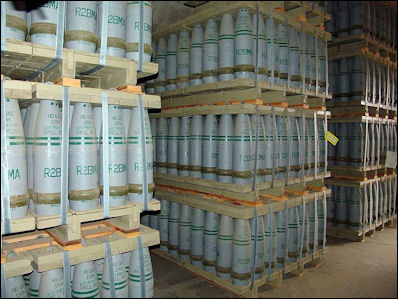
Mustard gas shells The Geneva Protocol of 1925 banned the use of chemical and biological weapons in war. The protocol was pursued in part to address the horrors caused by mustard gas and other chemical weapons used in World War I. The United States, the Soviet Union and 100 other nation signed the Biological Weapons Convention in 1972. Both the United States and the Soviet Union have violated the terms of the agreement. A Chemical Weapons Convention opened for signatures in 1993. The main problem with these agreements is verification.
The Soviet Union claimed it had eliminated its biological weapons stockpiles on the late 1980s. The United States claims that it eliminated its biological weapons stockpiles in the 1970s. Both countries agreed to destroy their stockpiles of chemical weapons by 2007. Both Russia and the United States claim they no longer make chemical or biological weapons but they continue to do research with them, and may be developing them. Both countries are behind schedule in destroy their weapons.
It is very difficult to control the spread of chemical and biological weapons and the materials and knowledge used to make them. There are great fears that the may be used in a terrorist attacks/
See BIOLOGICAL WEAPONS AND TERRORISM factsanddetails.com; CHEMICAL AND BIOLOGICAL WEAPONS IN RUSSIA factsanddetails.com;
Nerve Agents and VX
Some chemical weapons are nerve agents. The first nerve agent, tabun, was developed before World War II. All nerve agents work by blocking the body’s production of acetylcholinesterase, an enzyme that regulates the nerves that control certain muscles. Without acetylcholinesterase the diaphragm tightens, a victims goes into convulsions and dies gasping for air. Protection against nerve agents involves wearing a gas mask and an air tight suit that covers the entire body. A pretreatment with pyridostigmine can shield the body by sealing out acetylcholinesterase molecules. The drug atropine can reverse the effects if a victim is given it quickly enough. Nerve agents can be delivered in shells, bombs and rockets but the best way to disperse them is to spray them from an aircraft.

sarin gas bomb VX is a particularly deadly and potent nerve agent developed in Britain in the 1950s. It is an odorless, oily, amber liquid that can be sprayed from the air or dispersed from the ground. It penetrates through the skin, eyes and respiratory system, and blocks transmissions of impulses through the central nervous system, causing convulsions, respiratory paralysis and death. Early symptoms include a runny nose, small pupils, drooling, sweating and nausea.
VX can be absorbed through an orifice or the skin. A single drop can kill a person in minutes (a lethal dose is 10 milligrams on the skin and 50 milligrams inhaled). Two hundred tons could wipe out the world's population. VX is regarded as 100 times more deadly than sarin because it is thick and lingers in the environment longer than sarin.
The binary form of VX is the most desired form. It is comprised of two sets of chemicals that are not mixed until the last minute. This form is more stable and easier to handle. VX sprayed over a site the size of Disneyland could kill up to 12,500 people
Mustard Gas and Sarin
Mustard gas is a brownish or yellowish gas that can be sprayed in the air, fired in shells or dispersed from the ground. Used with horrible consequences in World War I, it penetrates through the skin, eyes and respiratory system, and causes painful, long-lasting blistering inside and outside the body. Early symptoms include red and itchy skin, a runny nose, sneezing and shortness of breath. Long term effects including chronic breathing difficulties and lung cancer. A lethal doses is 4,500 milligrams on the skin and 1,500 milligrams inhaled.
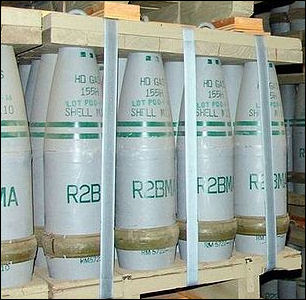
Mustard gas shells Even if a mustard gas victim is treated quickly, if he has been exposed to a lot of the gas, he will likely have long term effects. Sometimes the effects don’t even start until days or weeks after a person has been exposed. There is no treatment for mustard gas exposure. Only the symptoms can be treated. Many victims suffer from chronic bronchitis and blistering of the skin. Some lose their sight or become impotent.
Mustard gas was used o Iranian soldiers and Kurdish civilians during the Iran-Iraq War and was widely used in World War I. (See Below)
Sarin is an odorless highly- lethal nerve gas invented by the Nazis during World War II and used in a deadly subway attack in Japan. Similar to VX, it can be sprayed from the air or dispersed from the ground or fired in artillery shells. It penetrates through the skin, eyes and respiratory system, and blocks transmissions of impulses through the central nervous system, causing convulsions, respiratory paralysis and death. Early symptoms include a runny nose, severe headaches, chest tightness, drooling, sweating and nausea. A lethal doses is 1,700 milligrams on the skin or 70 milligrams inhaled.
Sarin is similar to modern pesticides. It kills by paralyzing the chest muscles and can result in death in as little as 15 minutes. It is lethal as long as it lingers in the air but it dissipates quickly. Sarin was used in the Tokyo subway attack in 1995.
Poison Gas in World War I

World War I
Livens Projector Components The Germans first used poison gas at Ypres. It was dispersed through pipes and nozzles and carried to the enemy by the wind. Chlorine gas introduced in April, 1915, mustard gas in July 1917. Phosgene was also used. Phosgene is a choking agent. It is colorless and reportedly smells like freshly mowed hay. It causes eye and airway irritation, pulmonary edema and choking. Poison gas used by Germany in 1915 was deemed to be ineffective.
Poisonous gas was also placed in explosive shells. When it is compressed in the shell, the gas was liquid. It vaporized at the moment of explosion. In some areas about four percent of the bombs contained poisonous gas.
The first poison gas attack occurred in April 1915 when the German army dispersed chlorine gas over trenches in Ypres, Belgium. A couple of months later the British retaliated with a chlorine attack of their own. Mustard gas was introduced later. It penetrated masks and clothing and burned the skins and lungs.
Herbert Young, a 112-year-old veteran at the battle told Newsweek in 1999, "I got gassed in the Army. Chlorine gas, the lung gas. It does make you sick. My friend got mustard gas; mustard gas was the worst gas. It never healed — wherever it was sore, it stayed sore. I guess in time the mustard gas killed them."
Poison Gas Attack at Ypres
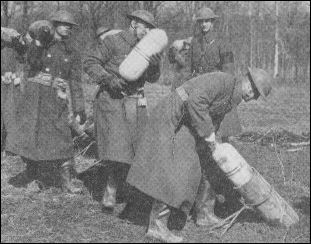
Loading Livens Projectors Describing a yellow cloud that drifted over an Algerian division at Ypres, the historian Lyn McDonald wrote: "from their position above the gas cloud Sutton and his officer, staring aghast, could hardly have heard the screams, the gasping, the choking as the gas cloud rolled across the troops — but they saw the panic — saw that the Algerians were running for their lives, throwing away rifles as they staggered and stumbled, dazed and terrified, away from the lethal fumes."
Describing the attack, a French army doctor wrote: "as we looked to our left we saw a thick, yellowish-green cloud veiling the sky like a cloud of vapor...I felt the action of the gas upon my respiratory system; it burned my throat, caused pains in my chest, and made breathing all but impossible. I spat blood and suffered from dizziness. We all thought we were going to die."
Phosgene Gas Attack at Messines Ridge
Describing a poison gas attack at Messines Ridge, William Pressey wrote, "We had been shooting most of the night and Germans had been hitting back with shrapnel, high explosives and gas shells...I was awakened by a terrific crash. The roof came down on my chest and legs. It thought, 'So, this is it then."
.jpg)
German chemical weapons in WW1 "I found I could hardly breath. Then I heard voices. Other fellows with gas helmets on, looking very frightened in the half-light, were lifting timber off me and one was forcing a gas helmet on me. Even when you were all right, to wear a gas helmet was uncomfortable, your nose pinched, such air through a canister of chemicals. As I was already choking I remember fighting against having this helmet on."
“The next thing I knew I was being carried on a stretcher...I suppose I resembled a kind of fish with my open mouth gasping for air. It seemed as if my lungs were gradually shutting up and my heart pounded away in my ears like the beat of a drum. On looking at the chap next to me I felt sick,, for green stuff was oozing from the side of his mouth."
"To get air into my lungs was real agony and the less I got the less the pain. I dozed off for short periods but seemed to wake in a sort of panic. To ease the pain in my chest I may subconsciously have stopped breathing, until the pounding of my heart woke me up gain. I was always surprised when I found myself awake, for I felt sure that I would die in my sleep."
"So little was known about treatment for various gasses, that I never had treatment for phosgene, the type I was supposed to have had. And I'm sure that the gas some of the other poor fellows had swallowed was worse than Phosgene. Now and then orderlies would carry out a stretcher."
Chemical Weapons Attack on Kurds in Iraq
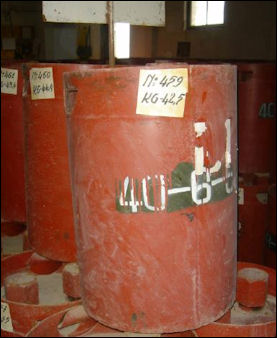
Albanian chemical weapons canister Thousands of Kurds were killed and perhaps a lot more when the Iraqis used chemical weapons on at villages in northern Iraq during the Anfal campaign in the Iran-Iraq war in 1987 and 1988. At least 60 villages were involved and at least 6,500 people were killed. Kurds have documented 281 uses of Iraqi poison gas.
Human Rights Watch estimated between 50,000 and 100,000 people were killed and called the attacks “attempted genocide.” Many more were affected: maybe 4 million Kurds, 10 percent of the population of northern Iraq. The gassing continued even after the Iran-Iraq war was over. The U.S. government was aware of the gassing but remained quiet about it at the time.
The gas attacks on the Kurds was the greatest poison gas attack ever against civilians (in World War I poison gas was used against other combatants). Christine Gosden, a medical geneticist at Liverpool University told the New Yorker, “For Saddam’s scientists the Kurds were a test population. They were human guinea pigs. It was a way of identifying the most effective chemical agents for use on civilian populations, and the most effective means of delivery.”
The Iraqis are believed to have used mustard gas, cyanide gas and the nerve agents sarin, tabun and VX. Biological agents may have also been used.
Study: “Iraq’s Crime if Genocide” by Human Rights Watch. Film: “The Winds of Death” by Gwynne Roberts.
Chemical Weapons Attack on Halabja

Halabja, Iraq March 1988 On March 16, 1988, at least 5,000 Kurds died and 20,000 were wounded in a chemical weapon attack at Halabja, a small city with 45,000 Kurds about 15 miles from the Iranian border and near the front lines in the Iran-Iraq war. The Kurds there were accused of collaborating and sympathizing with the Iranians. [Source: Jeffrey Goldberg, The New Yorker, March 25, 2002]
The attack began after a conventional artillery bombardment. It became clear something different was going on when helicopters flew over the town and threw out pieces of paper (apparently to gauge the wind speed and direction). Later planes dropped canisters on the town that produced a low muffled sound when they exploded and emitted a yellowish gas that hugged the ground as it dispersed.
One Kurdish woman named Nasreen told the New Yorker, “It wasn’t so loud. It was like pieces of metal just dropping without exploding. We didn’t know why it was so quiet...At first, it smelled bad, like garbage. And then it was a good smell, like sweet apples. Then like eggs.” The woman looked at a cage with a partridge in her house. “The bird was dying. It was on its side. It as very quiet, but the animals were dying. The sheep and goats were dying. I told everybody there was something wrong. There was something wrong with the air.”
Fleeing the Chemical Weapons Attack on Kurds
The woman and her family sought refuge in their cellar. She told the New Yorker, “My sister came close to my face and said, “Your eyes are very red.” Then the children started throwing up. They kept throwing up. They were in so much pain, and crying so much. They were all crying all the time. My mother was crying. Then the old people started throwing up...They children were crying, “We can’t see! My eyes are bleeding!” [Source: Jeffrey Goldberg, The New Yorker, March 25, 2002]
“We knew there was chemicals in the air. We were getting red eyes, and some of us had liquid coming out of them. We decided to run...Our cow was lying on its side. It was breathing very fast, as if it had been running. The leaves were falling off the trees, even though it was spring. The partridge was dead. There were smoke clouds around. The gas was heavier than the air, and it was finding the wells and going down the wells.”
The woman and her family fled in the direction opposite the wind direction. “The children couldn’t walk, they were so sick. They were exhausted from throwing up. We carried them in our arms. We wanted to wash ourselves and find water to drink. We wanted to wash the faces of the children who were vomiting. The children were crying for water. There was powder on the ground, white. We couldn’t decide whether to drink the water or not, but some people drank the water from the well because they were so thirsty.”
Victims of the Chemical Weapons Attack on Kurds
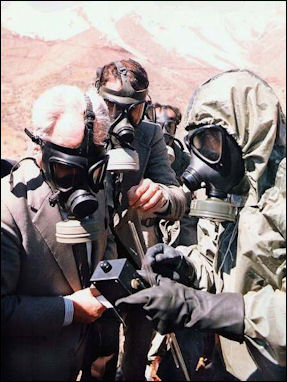
United Nations observers in Iran Some victims broke out in horrid laughter and stripped off their clothes and then died. Others yelled and ran into walls. Most people died on the streets trying to get out of town. Some ran down to the river and jumped in. Many of those that tried to hide in their houses were killed as the heavier than air gas seeped in through broken or open windows. [Source: Jeffrey Goldberg, The New Yorker, March 25, 2002]
Nasreen told the New Yorker, “People were showing different symptoms. One person touched some of the powder, and her skin started bubbling. We saw people lying frozen on the ground. There was a small baby on the ground, away from her mother. I thought they were both sleeping. But she had dropped the baby and then died. And I think the baby tried to crawl away, but it died, too. It looked like everyone was sleeping.”
Another survivor told the New Yorker, “On the road to Anab, many women and children began to die. The chemical clouds were on the ground. They were heavy. We could see them. Many children were left on the ground, by the side of the road. Old people as well. They were running, then they stopped breathing and died.”
Survivors of Chemical Weapons Attack on Kurds
Some survivors saved themselves by covering their face and bodies with wet towels. Others survived by making it to high ground or injecting themselves with atrophine. The Iranians captured Halabja. They took the survivors to Iranian hospitals and invited the foreign press to visit the town and take phonographs of the dead, which is how we know the story today. [Source: Jeffrey Goldberg, The New Yorker, March 25, 2002]
Many people went blind. Some for a few hours. Some several days. Some forever. Others had badly damaged lungs. Many women who survived started menstruating and it wouldn’t stop. They were given drugs to stop the bleeding but the were unable to bear children after that. Those that could bear children often gave birth to children with severe birth defects.
Others, years later, developed horrible cancers, skin diseases and chronic illnesses. Some experienced spells and recurring attacks similar to those in the original gas attacks. There were also reports of increased numbers of miscarriages, cleft palates and hare lips, mental, illness, and snake bites. Many people are believed to have suffered permanent DNA damage related to the attacks.
Tokyo Subway Sarin Gas Attack
On March 22, 1995, sarin, a lethal nerve gas invented gas invented by the Nazis during World War II, was released by Aum members on three Tokyo subway trains during the morning rush hour. The attack left 12 dead, 3,807 seriously injured and sickened 6,300 others. One victim who stayed in a train for about 40 minutes without realizing what had happened said he still had shuddered headaches and weight loss 15 years after the attack. Another victim died in 2008 after spending 14 years in a coma.
The Tokyo subway attack was reportedly intended by Aum to "set off massive confusion in the Tokyo area" and divert the attention of the police who were believed to be planning a raid of the cult's headquarters. It was also apparently an effort by cult members to spark the cataclysmic Armageddon that Asahara had predicted and "purify" Japan through global violence. The last major terrorist attack in Japan before the 1995 Aum subway gassing was a bomb detonated by in a radical leftist group in 1974 in the central Tokyo business district that killed eight people and injured nearly 400.
The poison gas was placed in containers disguised as school lunch boxes and soft-drink containers. It was released simultaneously in five subway cars on three trains heading towards Kasumigaseki, an area of Tokyo where most of the top government agencies have their offices. If the trains hadn’t stopped when the gas was released they all would have arrived at Kasumigaseki station between 8:09am and 8:14am.
See Separate Article AUM SHINROKYO CULT AND THE TOKYO SUBWAY SARIN GAS ATTACK factsanddetails.com
Image Sources: Wikimedia Commons
Text Sources: New York Times, Washington Post, Los Angeles Times, Times of London, The Guardian, National Geographic, The New Yorker, Time, Newsweek, Reuters, AP, AFP, Wall Street Journal, The Atlantic Monthly, The Economist, Global Viewpoint (Christian Science Monitor), Foreign Policy, Wikipedia, BBC, CNN, NBC News, Fox News and various books and other publications.
Last updated July 2012
